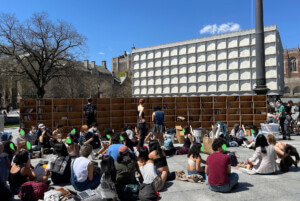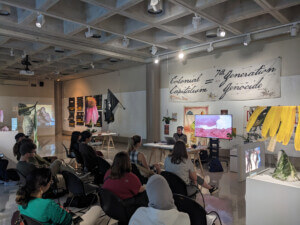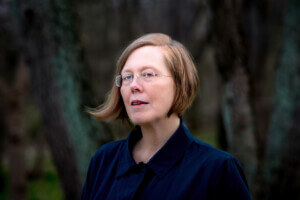It’s the start of the 2023–24 academic year, so that means a new crop of leaders are beginning the semester. To check in, AN spoke with a set of leading educators about their roles. Each answered a septet of questions; the third in this series is Milton Curry, Senior Associate Dean for Strategic Initiatives and Engagement and Professor, Architecture at Cornell
College of Architecture, Art, and Planning (AAP).
What are your goals and ambitions for your new role?
I will be engaged in expanding the College of Architecture, Art and Planning through research, arts-integrated education, and grants in ways that uplift and respect the rigor of our Research 1 university.
Working collaboratively with the College’s talented leadership team and with Dean J. Meejin Yoon, I hope to accelerate many of the Dean’s major initiatives in linking the College’s Ithaca and New York campuses, supporting new technology-oriented degrees and research, and supporting new programs in real estate development.
Who is someone who has inspired your work and leadership? Why are they inspirational?
I am inspired by the work of Earl Lewis, former President of the Andrew W. Mellon Foundation. Under Earl’s leadership at Mellon, the Architecture, Urbanism and Humanities grants were established—the first that I know of in the foundation’s history to support innovative research that cut across architecture/urban design and the humanities. These grants were transformative for all the institutions that received them. Earl has also set up the Academic Leadership Institute (ALI) to train the next generation of diverse academic leaders; and his UM Center for Social Solutions is publishing great research on diversity and producing new knowledge around the future of work and the possibilities for reparations.
What are the most urgent topics and challenges for architectural education today?
Embracing the political, socio-economic and cultural present that we find ourselves in. We must 1) defend the democratic egalitarian space of the university, protecting it against enemies foreign and domestic; and 2) defend the necessity to better understand the repair that is owed to those who have been wronged by failed policies of the past that have endangered lives and livelihoods, land ownership, the ability to live free of environmental harm and the ability to have equivalent opportunities as all in the society.
Architecture and urban design must be part of the conversation about how to build, sustain and maintain social order through equitable and diverse means. Technology will not solve social, cultural, political problems without a proper humanistic lens. Architecture education provides a simultaneous humanistic and aesthetic/spatial lens from which to cohere new socialities. Architecture education, then offers itself as a field that seeks to make the world better, and more humane.
How has the COVID-19 pandemic changed your thinking about being a leader in higher education, if it has?
I don’t believe that online education will ever be the dominant delivery system for higher education. Though I believe it will become a more important component of our educational ecosystem. I do think that what Covid and the pandemic showed us is that low-wage workers and their dignity, equitable treatment, and fair pay is critical to making our economy and our universities work. The mental health of all our employees and students must be at the core of how we think about human resources and our culture in academia. Lastly, the pandemic taught us that the United States has a subpar social safety net whereby excess supply—of hospital beds in the case of the pandemic—are not present because it is not in the business interests of hospitals to finance them; and because the government has not invested in them. If we extend this to homelessness, affordable housing or parks, we find the similar scenarios of either underinvestment or relying on philanthropy to meet the gap of what government and for-profit sectors are willing to provide. Architects must be more proactive in providing services that are at the front-end of these policy debates.
How should the topic of sustainability be incorporated into architectural education?
Sustainability has become an all-encompassing term. We need to unpack it—climate precarity, migration due to climate change, environmental racism, socio-economic divisions in resource allocation, accessibility to insurance (flood, fire, earthquake), etc. Once we unpack it, we need to institutionalize intersectional approaches that are customized to the communities affected by the particularities of the situation—whether it be in California or New York or India.
How should the goals of diversity and inclusivity be advanced under your leadership?
My role is not specifically to oversee the College’s efforts here—we have other talented leaders who are overseeing that area. But as a leader, and as a member of the university community, it is our collective obligation to be proactive in addressing past wrongs and any conditions that potentially impede progress for any of our students, particularly those that are underrepresented. Being open to broad conversations with our fellow citizens and adapting to the tactics and strategies that will make us more humane.
What are you optimistic about as you create the future of architecture and architectural education?
The future is in great hands. Our students today are more diverse, more culturally open, and open to change. That allows educators to broaden and deepen the forms of intellectual engagement that we co-create. Podcasting, broadcasting ideas via social media, utilizing video and other forms of media to communicate ideas—these offer extraordinary opportunities to use our talents and our training to reach a broader community that just connoisseurs. I find this to be a very exciting time to both reimagine architectural education, and to be an architect working as what I have called a “citizen architect” engaged in public and civic actions, activations and imaginings.











